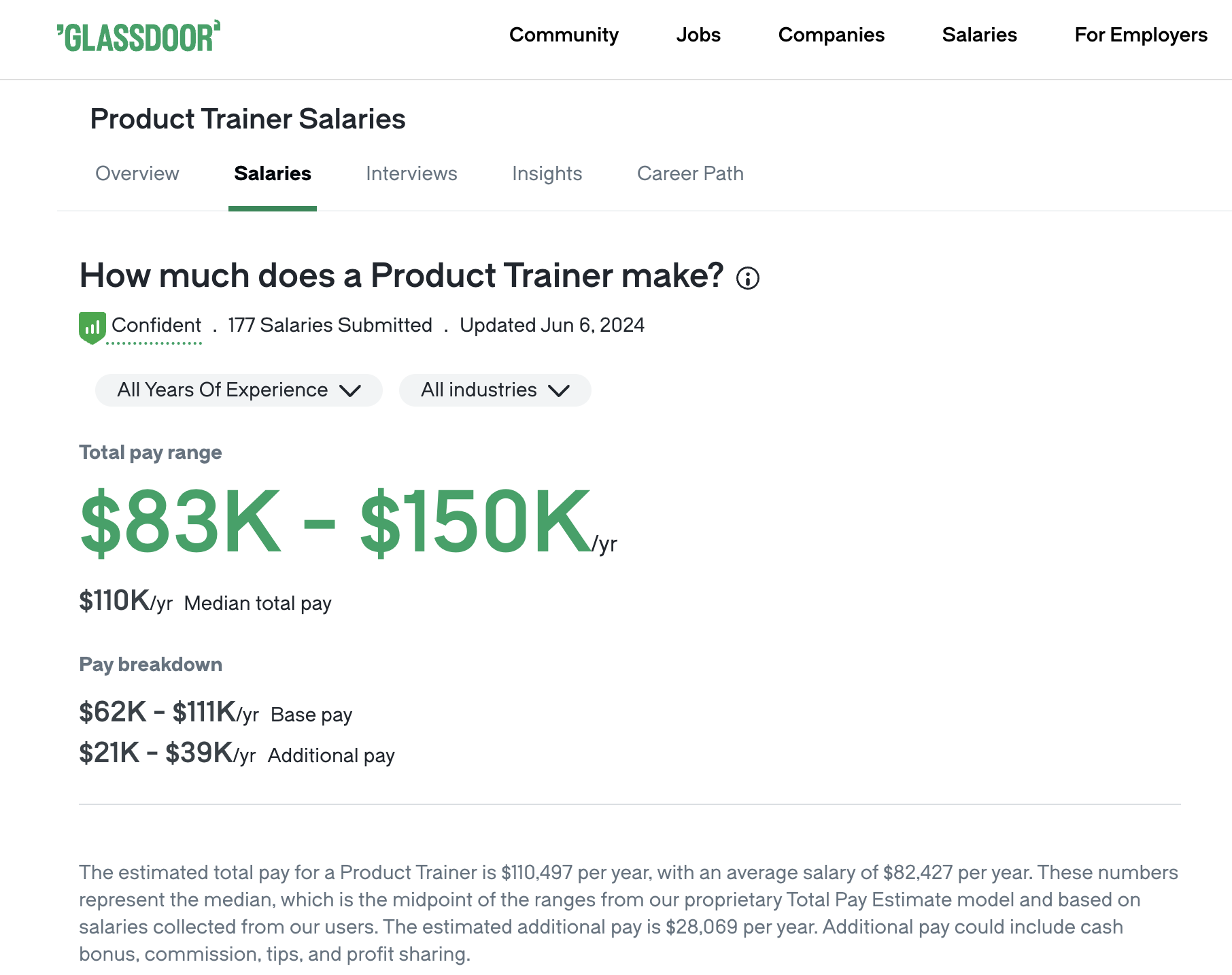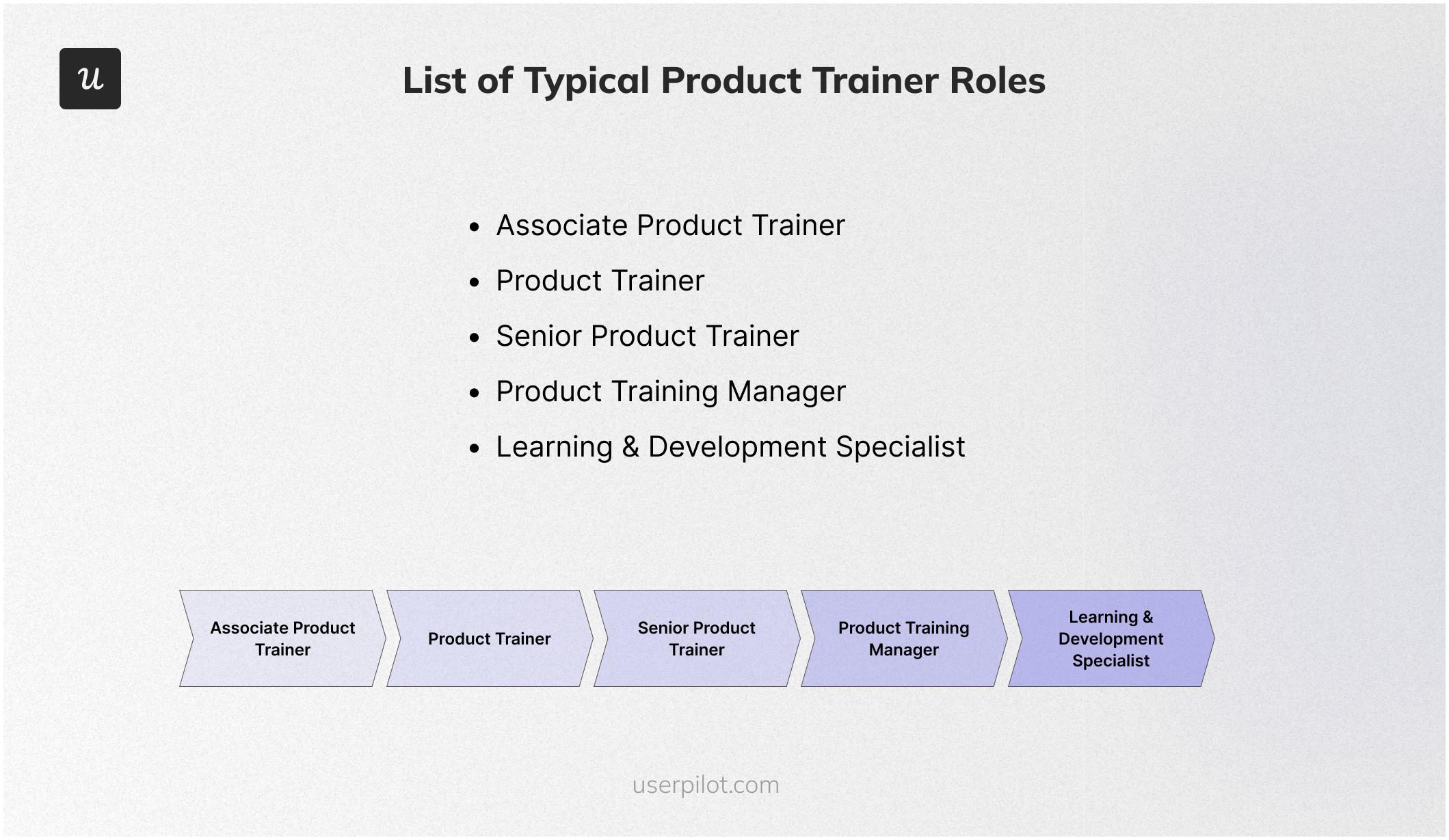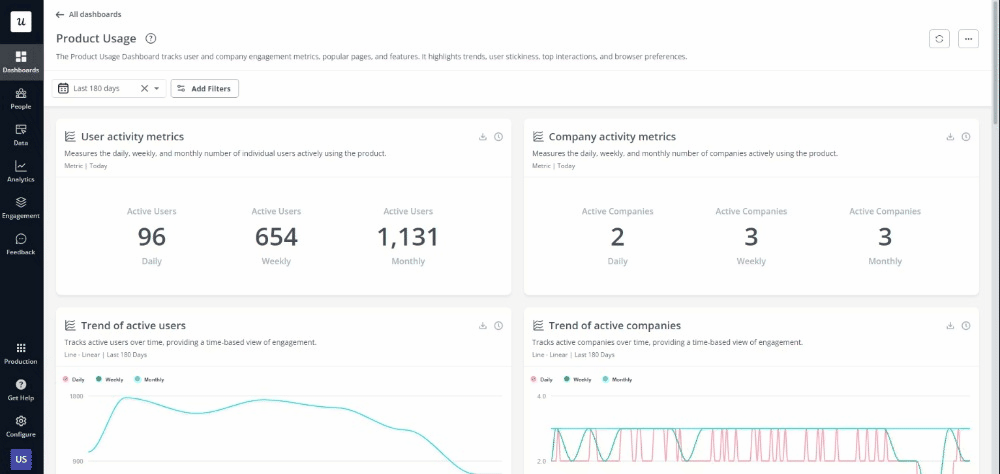
Starting a career as a product trainer requires understanding the key steps, skills, and experiences needed for success.
In this article, we will outline the typical journey for product trainers, covering educational requirements, entry-level positions, potential advancements, and long-term opportunities.
Without further ado, let’s get into it!
Try Userpilot Now
See Why 1,000+ Teams Choose Userpilot

Product trainer career path – quick summary
- A product trainer is a specialist who educates people about a company’s products or services.
- Product trainers typically develop training materials, deliver presentations, and assess learning outcomes. They may also use various training methods, like lectures, demonstrations, role-playing exercises, and online modules.
- According to popular hiring platforms like Glassdoor, the average salary for a product trainer in the US falls between $65,000 and $80,000 annually.
- The product trainer role offers a rewarding career path with opportunities for advancement. Here’s a roadmap outlining potential progression paths:
- Associate Product Trainer (1-3 years)
- Product Trainer (3-5 years)
- Senior Product Trainer (5+ years)
- Product Training Manager (7+ years)
- Learning & Development Specialist (8+ years)
- Becoming a product trainer involves developing a blend of expertise in the product you are training on, strong communication skills, and a knack for teaching.
- As a product trainer, leveraging the right tools can make all the difference in delivering high-quality, impactful training experiences. So here are few of the top tools that product trainers can use to create effective training programs (keep reading for more tools):
- Userpilot: Userpilot is your one-stop shop for creating smooth and engaging user onboarding experiences. With interactive walkthroughs, targeted messages, and personalized guidance, you’ll have users mastering your product in no time. The data-driven insights also help you continuously refine your training strategy.
- Pendo: This product experience platform provides deep insights into how users interact with software. By understanding user behavior and gathering feedback, trainers can tailor their materials to real user needs and drive product improvements.
- Appcues: A low-code user onboarding platform that works for both web and mobile applications. It simplifies the creation of intuitive walkthroughs and tooltips.
- UserGuiding: Similar to Appcues, UserGuiding also offers user surveys and NPS tools. This enables trainers to gather valuable feedback during the onboarding process.
- WalkMe: Reduces the need for manual support by guiding users through complex tasks and processes. It also comes with AI chatbots to provide real-time assistance.
- Looking into tools for product trainers? Userpilot is an all-in-one product platform with engagement features and powerful analytics capabilities. Book a demo to see it in action!
What is a product trainer?
A product trainer is a specialist who educates people about a company’s products or services. They can train various audiences, including:
- New employees: Equipping them with the knowledge to effectively use the product within the company.
- Sales teams: Helping them understand the product’s features and benefits to better sell it to customers.
- Customers: Providing them with the knowledge to use the product to its full potential.
What does a product trainer do?
Product trainers typically develop training materials, deliver presentations, and assess learning outcomes. They may also use various training methods, like lectures, demonstrations, role-playing exercises, and online modules.
In short, they bridge the gap between a product and its users by ensuring everyone has the knowledge to use it effectively.
Product trainer’s main responsibilities
Product trainers play a crucial role in ensuring that employees, customers, or partners understand and effectively use a company’s products or services. Their responsibilities are diverse and can vary depending on the industry, company size, and product complexity. However, here are some core duties:
- Design and develop training materials, including presentations, workshops, webinars, e-learning modules, and hands-on exercises.
- Deliver engaging and informative training sessions tailored to different audiences and learning styles (i.e. onboarding new employees and customers on product usage).
- Troubleshooting technical issues and providing product support.
- Stay up-to-date on product updates, new releases, and industry trends.
- Gather feedback from trainees and stakeholders to assess training needs and identify areas for improvement.
Product trainer salary

According to popular hiring platforms like Glassdoor, the average salary for a product trainer in the US falls between $65,000 and $80,000 annually.
However, this is just a starting point. Several factors can significantly influence a product trainer’s salary.
For example, entry-level trainers earn around $45,000-$55,000 annually, while those with 6+ years of experience can command upwards of $70,000.
Location also impacts earnings, with major tech hubs like San Francisco, New York City, and Seattle offering higher compensation packages compared to smaller cities.
Product trainer career path

The product trainer role offers a rewarding career path with opportunities for advancement. Here’s a roadmap outlining potential progression paths:
- Associate Product Trainer (1-3 years): Assist senior trainers with user onboarding, create training materials, and gain a strong understanding of the product.
- Product Trainer (3-5 years): Design and deliver comprehensive training programs for various user groups using your training skills and product knowledge.
- Senior Product Trainer (5+ years): Lead and manage a team of trainers, develop training strategies, and ensure high-quality training experiences.
- Product Training Manager (7+ years): Oversee the entire product training function, manage budgets, and ensure training aligns with business goals.
- Learning & Development Specialist (8+ years): Lead the broader learning and development function, encompassing product training and other areas like employee onboarding.
How to become a product trainer
Becoming a product trainer involves developing a blend of expertise in the product you are training on, strong communication skills, and a knack for teaching. Here’s a roadmap to get you started:
Education and foundation:
- Formal education (optional but valuable): A bachelor’s degree in Training and Development, Instructional Design, Education, or a related field can provide a strong foundation in adult learning principles and instructional methods. While not always mandatory, it can be a plus for employers, especially for senior positions.
- Self-learning: If you don’t have a formal degree, don’t fret. Many online courses and certifications are available in product training, instructional design, and adult learning methodologies. Sites like Coursera, Udemy, and LinkedIn Learning offer a wealth of options.
Experience and skill building:
- Start in a related field: Look for entry-level positions in Learning and Development, Customer Success, or Technical Support. These roles can expose you to training principles and content creation, even if it’s not product-specific.
- Seek an internship: If you’re a student or early in your career, consider an internship focused on training or instructional design. This can provide valuable hands-on experience and build your resume.
- Network and learn from others: Connect with product trainers on LinkedIn or online communities. Shadowing experienced trainers can offer invaluable insights into their work and presentation techniques.
Building your product expertise:
- Focus on a specific industry: Research industries that interest you and delve deep into their typical products. This focused knowledge will be highly sought-after by potential employers.
- Build your tool knowledge: Familiarize yourself with the onboarding tools and Learning Management Systems (LMS) commonly used in the industry, i.e. Userpilot for user onboarding, Walkme or Coassemble for employee onboarding, etc.
- Become a product power user: Get to know the product inside and out. Explore all its features, delve into user manuals and documentation, and actively use the product yourself. This deep understanding will make you a more credible trainer.
Best resources for product trainers
Product trainers play a crucial role in driving user adoption and ensuring the success of any product. Here are some of the best resources for product trainers, categorized to help you find exactly what you need:
Best books for product trainers
To excel in this role, continuous learning and development are essential. Here are five books highly recommended for product trainers, covering various aspects of training, product management, and customer success:
- “Telling Ain’t Training” by Harold D. Stolovitch & Erica J. Keeps: A classic on the science of adult learning and how to design effective training programs.
- “Design for How People Learn” by Julie Dirksen: Explores cognitive science principles and translates them into actionable strategies for creating engaging learning experiences.
- “The Lean Product Playbook” by Dan Olsen: Provides a framework for building products that customers love, with valuable insights for trainers on understanding customer needs and validating product ideas.
- “The Effortless Experience” by Matthew Dixon, Nick Toman & Rick DeLisi: Provides a framework for delivering low-effort customer experiences and improving customer loyalty.
- “The Challenger Sale” by Matthew Dixon & Brent Adamson: Offers insights on how to challenge customers’ assumptions and create buying urgency, relevant for trainers involved in sales enablement.
Best webinars for product trainers
Webinars offer a convenient and accessible way to gain valuable insights, learn new strategies, and connect with industry experts. Here are some highly recommended webinar sources for product trainers:
- Userpilot Events: Focuses on product growth and user onboarding, crucial for understanding user behavior and crafting effective training programs. Their webinars cover topics like user journey optimization, feature adoption analytics, and user engagement strategies – all feeding directly into your training initiatives.
- Mind the Product Webinars: Known for their high-quality webinars on various product management topics, including training and onboarding. Their sessions often feature industry experts sharing their knowledge and experience.
- Pragmatic Institute Webinars: Provides webinars on various aspects of product management, including training and development. Their sessions often focus on practical skills and real-world scenarios.
- Product-Led Growth Collective Webinars: This community-driven platform offers webinars on various aspects of product-led growth, including user onboarding and product adoption.
Best blogs for product trainers
Here are some of the best blogs for product trainers, offering practical guides, expert interviews, and actionable advice:
- Userpilot Blog: Offers in-depth guides, case studies, and actionable advice on creating effective onboarding experiences, improving product adoption, and driving user engagement.
- Product Talk: Features interviews with product leaders and experts, offering insights into their strategies and tactics. Covers a wide range of industries and company sizes.
- Roman Pichler’s Blog: Offers in-depth articles and resources on applying agile methodologies to product management. Provides valuable insights for trainers who want to create flexible and adaptable training programs.
- ProductPlan Blog: Provides practical advice and templates for creating effective product roadmaps. It also offers insights into prioritizing features, aligning stakeholders, and communicating product strategy.
Best podcasts for product trainers
Curious about what the top product trainers are listening to? These are the podcasts generating buzz in the community, packed with insights and discussions to help you stay updated:
- The Product Experience: Hosted by product experts Lily Smith and Randy Silver, this podcast goes deep with industry leaders, covering a wide range of topics relevant to training, including user onboarding, product adoption, and customer success.
- Rocketship.fm: It is a great podcast for getting inspired and motivated. It’s packed with stories of entrepreneurs who have overcome challenges and built amazing products.
- Masters of Scale: Hosted by Reid Hoffman (co-founder of LinkedIn), this podcast explores how companies grow from zero to a gazillion. While not directly focused on training, it offers valuable lessons on scaling products and building successful teams.
- The Knowledge Project: Hosted by Shane Parrish, this podcast features in-depth conversations with experts from various fields. Trainers can gain insights into topics relevant to their work, such as learning, communication, and decision-making.
Best tools for product trainers
As a product trainer, leveraging the right tools can make all the difference in delivering high-quality, impactful training experiences.
So here are the top 10 tools that product trainers can use to create effective training programs:
- Userpilot: Userpilot is your one-stop shop for creating smooth and engaging user onboarding experiences. With interactive walkthroughs, targeted messages, and personalized guidance, you’ll have users mastering your product in no time. The data-driven insights also help you continuously refine your training strategy.
- Pendo: This product experience platform provides deep insights into how users interact with software. By understanding user behavior and gathering feedback, trainers can tailor their materials to real user needs and drive product improvements.
- Appcues: A low-code user onboarding platform that works for both web and mobile applications. It simplifies the creation of intuitive walkthroughs and tooltips.
- UserGuiding: Similar to Appcues, UserGuiding also offers user surveys and NPS tools. This enables trainers to gather valuable feedback during the onboarding process.
- WalkMe: Reduces the need for manual support by guiding users through complex tasks and processes. It also comes with AI chatbots to provide real-time assistance.
- Usetiful: Usetiful’s flexibility allows trainers to create a variety of training materials for different stages of the user journey.
- HelpHero: It is a knowledge base platform that allows you to build a self-service resource center for users.
- HelpScout: It is a customer support platform with a robust help desk and live chat features.
- Intercom: Intercom allows trainers to proactively engage with users and offer personalized support with targeted messages and AI chatbots.
- Spekit: Spekit is a just-in-time learning platform that integrates with various tools to deliver contextual training and knowledge reinforcement.
Conclusion
We hope our article has given you a good overview of the career path for product trainers.
Whether you’re just starting out or looking to advance, the key is to stay curious, keep learning, and remain open to new opportunities along the way.
Looking into tools for product trainers? Userpilot is an all-in-one product platform with engagement features and powerful analytics capabilities. Book a demo to see it in action!







